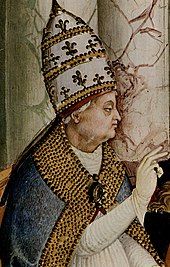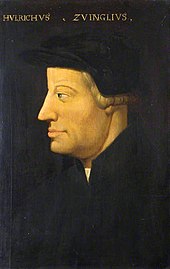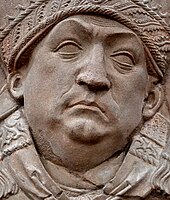Renaissance humanism in Northern Europe
This article relies largely or entirely on a single source. (October 2007) |
However, the Netherlands was influenced by humanism and the Renaissance until arguably roughly 1550.[1]
Marked features distinguished the new culture north of the
Overview

In the North, humanism entered into the service of religious progress. German scholars were less brilliant and elegant, but more serious in their purpose and more exact in their scholarship than their Italian predecessors and contemporaries. In the South, the ancient classics absorbed the attention of the literati. It was not so in the North. There was no consuming passion to render the classics into German as there had been in Italy. Nor did Italian literature, with its often relaxed moral attitude, find imitators in the North.
What was true of the scholarship of Germany was also true of its art. The painters, Albrecht Dürer (1471–1528), who was born and died at Nuremberg, Lucas Cranach the Elder (1472–1553), and for the most part Hans Holbein the Younger (1497–1543), took little interest in mythology, apart from Cranach's nudes, and were persuaded by the Reformation, though most continued to take commissions for traditional Catholic subjects. Dürer and Holbein had close contacts with leading humanists. Cranach lived in Wittenberg after 1504 and painted portraits of Martin Luther, Philip Melanchthon and other leaders of the German Reformation. Holbein made frontispieces and illustrations for Protestant books and painted portraits of Erasmus and Melanchthon.
The Italian roots of humanism in Germany

If any one individual more than another may be designated as the connecting link between the learning of Italy and Germany, it is
To the Italians, Germany was a land of barbarians. They despised the German people for their rudeness and intemperance in eating and drinking. Aeneas was impressed by the beauty of Vienna, though it was quite small when compared to the greatest Italian cities.[2] However, he found that the German princes and nobles cared more for horses and dogs than for poets and scholars and loved their wine-cellars better than the muses. Campanus, a witty poet of the papal court, who was sent as legate to the Diet of Regensburg (1471) by Pope Paul II, and afterwards was made a bishop by Pope Pius II, abused Germany for its dirt, cold climate, poverty, sour wine and miserable fare. He lamented his unfortunate nose, which had to smell everything, and praised his ears, which understood nothing. Johannes Santritter, himself being a German living in Italy, admitted that Italy was slightly ahead of Germany in the humanities. However, he also contended that many Italians were jealous of German science and technology, which he considered superior taking the examples of the printing press and the work of the astronomer Regiomontanus.
Such impressions were soon offset by the sound scholarship which arose in Germany and the Netherlands. And, if Italy contributed to Germany an intellectual impulse, Germany sent out to the world the printing press, the most important agent in the history of intellectual culture since the invention of the alphabet.
Universities
Before the first swell of the new movement was felt, the older German universities were already established:
Most of these universities had the four faculties, although the popes were slow to give their assent to the sanction of the theological department, as in the case of Vienna and Rostock, where the charter of the secular prince authorized their establishment. Strong as the religious influences of the age were, the social and moral habits of the students were by no means such as to call for praise. Parents, Luther said, in sending their sons to the universities, were sending them to destruction, and an act of the Leipzig university, dating from the close of the 15th century, stated that students came forth from their homes obedient and pious, but "how they returned, God alone knew", to university archives and library.
In the Netherlands, universities or "Latin schools" spurred on by Renaissance humanists helped the majority of people in the region become more literate than in most other European kingdoms.[1]
Education
The theological teaching was ruled by the

Heidelberg, chartered by the elector
In 1474, a chair of poetry was established at Basel. Founded by Pius II, it had among its early teachers two Italians, Finariensis and Publicius.
Leipzig and Cologne remained inaccessible strongholds of scholasticism, till Luther appeared, when Leipzig changed front. The last German university of the
As seats of the new culture, Nuremberg and
Popular education, during the century before the Reformation, was far more advanced in Germany than in other nations.[
Among the noted schoolmasters was
Leaders of Northern humanism
The leading Northern humanists included

Another Humanist was
A name which deserves a high place in the German literature of the last years of the Middle Ages is
See also
- German new humanism
- German Renaissance
- Northern Renaissance
- Renaissance in the Low Countries
References
Sources
- Philip Schaff, History of the Christian Church, Volume VI, 1882.
Further reading
- Marco Heiles: "Topography of German humanism 1470-1550. An approach".
